Do you have a general idea of how people view your brand?
Research shows that there’s a discrepancy between companies’ opinions on customer satisfaction and reality.
Automated sentiment analysis can help nip this discrepancy in the bud.
💡 Read Sentiment Analysis 101: Everything You Need to Know
It works by automatically mining customer reviews, interactions on social media platforms, and comments on industry forums and online communities.
Powered by AI technology, sentiment analysis tools search through each dataset and analyze certain words, phrases, or text.
What Is Sentiment Analysis?
Sentiment analysis, also known as opinion mining, is the process of using artificial intelligence to analyze customer feedback, survey responses, and product reviews.
How? With the ever-improving natural language processing (NLP) and machine learning (ML) technology at its core.
As the technology analyzes sentiment, it assigns a score, usually on a scale of -100 to 100, and each zero is considered neutral.
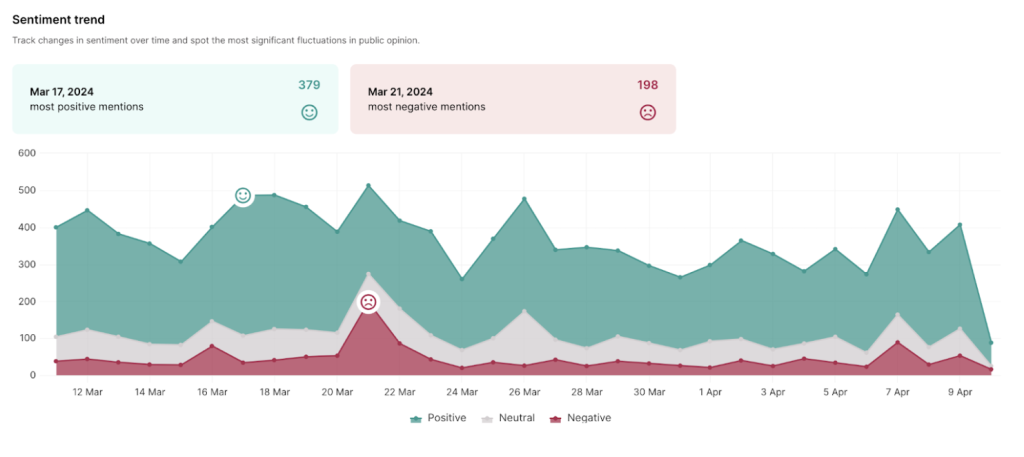
Here’s what that looks like in action:
You use a sentiment analysis tool, enter the data you want it to analyze, and search for a keyword or phrase like “price.”
The tool will assign a score based on that key phrase to help you determine whether the surrounding sentiment is positive, negative, or neutral.
So, for example, if it’s positive, that means customers are happy with the price of your product or service.
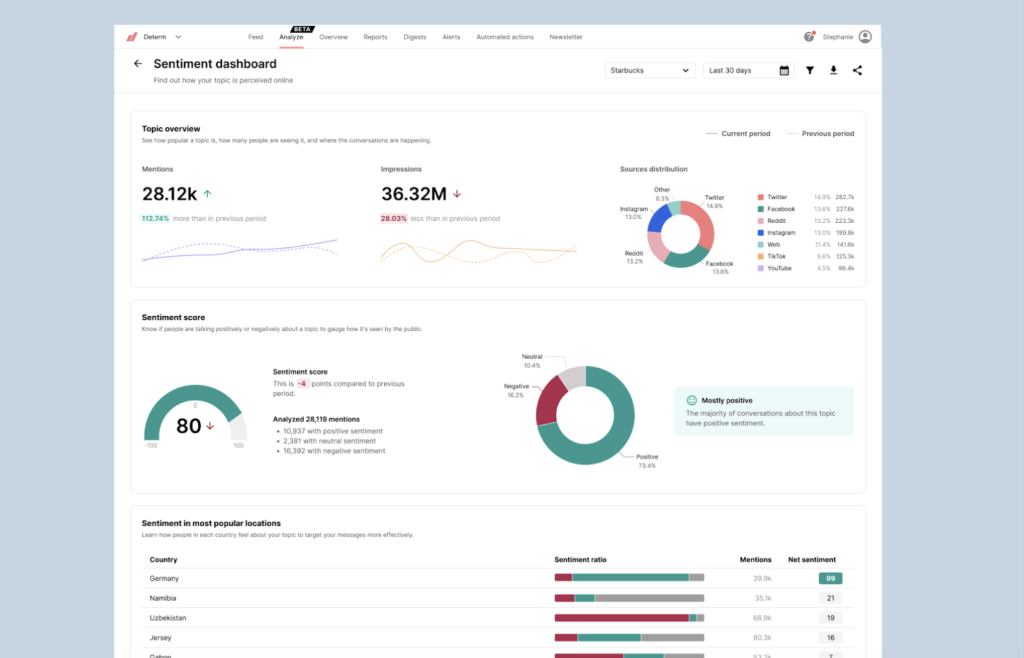
Sentiment analysis with Determ
Using a sentiment analysis tool beats the alternative. For example, with hundreds of thousands of reviews on Amazon, Mighty Patch acne pimp patches are a popular skincare product.
It’s humanly impossible to manually go through each online review, assign an accurate sentiment score for each, and determine the overall sentiment for the product.
Thankfully, sentiment analysis tools automate the process for you. No heavy lifting, errors or bias. This technology can be integrated seamlessly with a customer data platform (CDP), allowing you to connect sentiment insights with broader customer profiles and behavior data for deeper understanding and personalized engagement.
Benefits
There’s no question that automated sentiment analysis has some meaningful advantages, which include:
- Sort data at scale: Trying to sort through thousands of social media posts, customer service interactions, or surveys is enough to give anyone a headache. That’s an overwhelming amount of data to process manually. Automated sentiment analysis allows you to process huge amounts of unstructured data at scale.
- Real-time analysis: Sentiment analysis allows you to analyze data quickly, such as a new product or new policy proposal, in real time.
- Consistent criteria: When you use a centralized sentiment analysis tool, you can apply the same criteria to all of your data, improving accuracy and gaining better insights. That’s because AI-powered sentiment analysis software removes bias. As a result, you’ll get consistent and objective results every time.
- Improve products and services: It’s known that receiving customer feedback and criticism can help businesses improve their products. Using AI-driven software allows you to glean valuable insights and get an overall view of the customer experience with your product or service.
Use Cases
Sentiment analysis has several use cases. Some of the most popular ways businesses use sentiment analysis are:
- Social media monitoring: Many brands use sentiment analysis to gain insights into how customers feel about certain topics and detect urgent issues.
- Brand monitoring: Organizations monitor mentions and conversations around their brands online, whether these conversations take place on social media, blogs, forums, or news articles.
- Customer service: Customer support teams use sentiment analysis tools to better serve customers. They analyze the conversation and then personalize the experience based on words, emotions, or other cues. Companies can also use sentiment analysis to organize customer support queries by topic and urgency. As a result, they can route these queries to the relevant department and handle the most urgent issues right away.
- Market research: Sentiment analysis can come in handy when conducting market research. Some brands use sentiment analysis to find out what customers like and don’t like about their products.
- Campaign performance: Sentiment analysis technology can help businesses measure the performance of marketing and advertising campaigns based on what customers are saying. Tracking conversations on social media platforms allows them to determine overall sentiment. Marketers can tweak their campaigns in real-time if the feedback is generally negative.
- Voice of customers (VoC): Sentiment analysis tools can be useful in analyzing qualitative customer data, such as open-ended survey responses. These tools can classify responses as positive or negative, offering insights into VoC.
- Strategic planning: Automated sentiment analysis helps determine public sentiment and engagement for all organizations, including non-profit businesses. By integrating sentiment analysis into the strategic framework outlined in a non-profit business plan template, organizations can gain valuable insights into donor sentiments, community feedback, and overall public perception.
Other applications of sentiment analysis include:
- Stock market sentiment and market movement
- Voice of the employee
- Movie review analysis
- Election polls
Types of Sentiment Analysis
Sentiment analysis tools help businesses determine whether a text is positive, negative, or neutral. They can also identify feelings and emotions, such as anger, happiness, or sadness.
These AI-powered platforms can also detect urgency and even intentions (i.e., interested vs. not interested).
Within your sentiment analysis tool, you can control your results using these criteria, depending on how you want to analyze customer feedback.
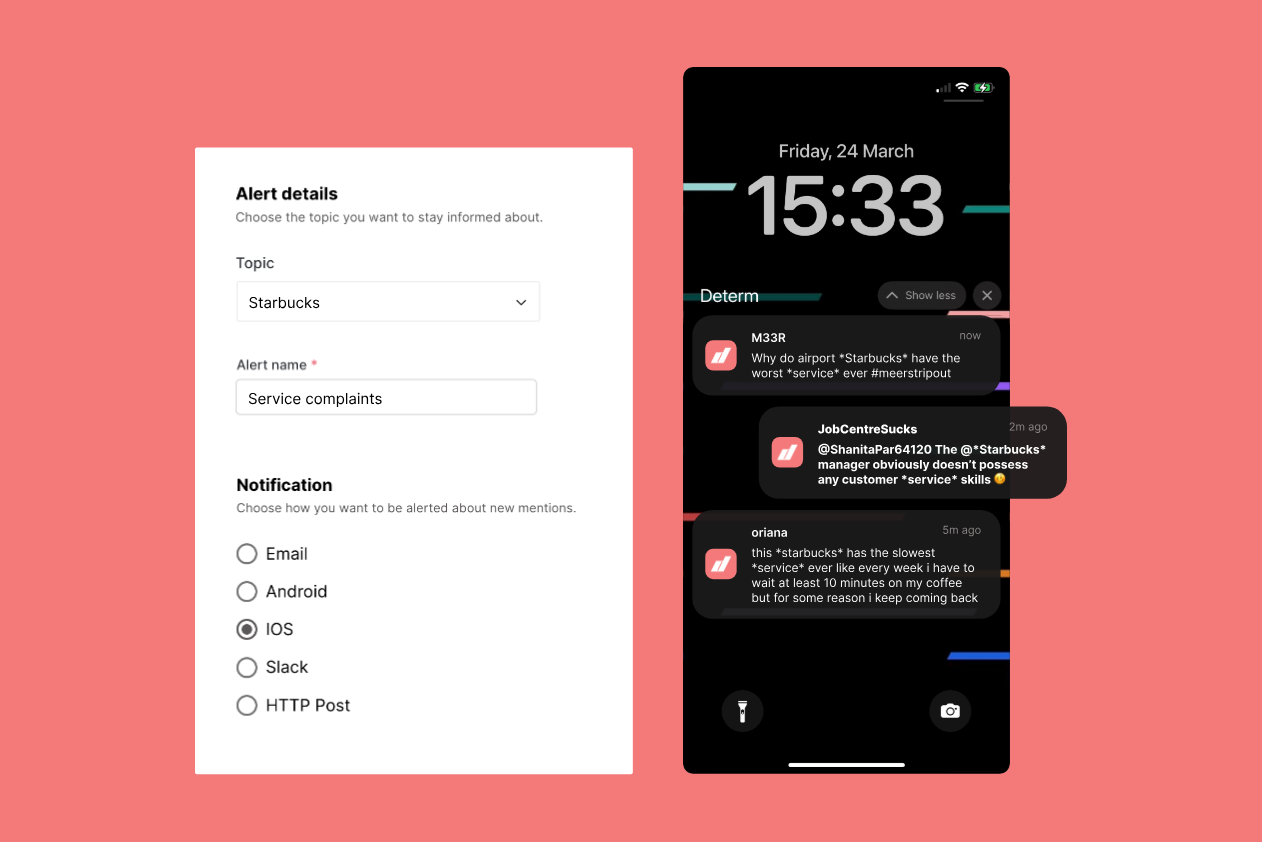
Get notified when someone talks about you online with Determ.
Here are some of the most common types of sentiment analysis:
- Aspect-based: Through aspect-based sentiment analysis, you can determine how customers feel about certain aspects of your product or service (e.g., the battery life of this camera is too short).
- Intent-based: Intent-based sentiment analysis allows you to determine a customer’s true intent. For example, if your analysis constantly picks up words like discounts or deals, it could mean that your customers want to save money.
- Emotion detection: This type of sentiment analysis goes beyond polarity (positive, negative, neutral) to identify emotions within customer conversations.
Sentiment Analysis Examples
Here are some examples of sentiment analysis of customer feedback and the polarity that a sentiment analysis tool might apply to them.
- The iPhone 15 has impressive features. (Sentiment: Positive)
- I find Google’s search engine to be the most efficient. (Sentiment: Positive)
- Amazon’s Prime delivery service is incredibly fast and reliable. (Sentiment: Positive)
- I’m frustrated with the constant bugs in Microsoft’s Windows updates. (Sentiment: Negative)
- I had a terrible experience with Uber’s customer support. (Sentiment: Negative)
- Netflix’s original series are consistently entertaining. (Sentiment: Positive)
- The quality of Starbucks’ coffee is consistently disappointing. (Sentiment: Negative)
A Step-by-Step Guide to Conducting Sentiment Analysis
Here’s a quick glimpse into how you can conduct your sentiment analysis with the help of a sentiment analysis tool.
1. Collect Data
Get your hands on the data you’ll use for sentiment analysis.
You can use a combination of data from different sources or data from just one source.
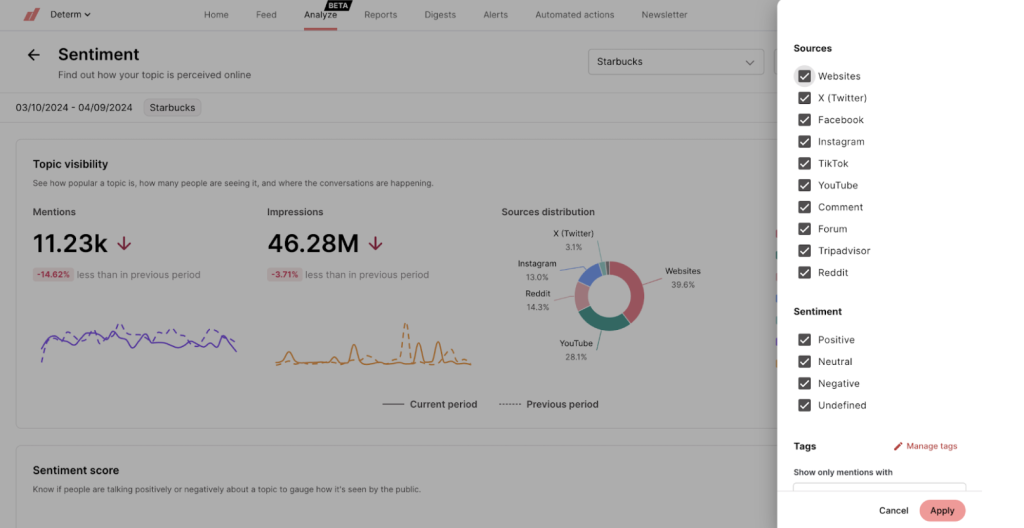
Track your brand mentions across different sources and media with Determ.
Consider uploading your data through a live application programming interface (API). This will allow you to collect data from platforms like:
- X (formerly Twitter)
- Amazon
- Yelp
If you’re wondering what API to use, these platforms will provide one (e.g., Twitter API, Facebook Graph API), allowing you to access data in a structured way.
You can also gather data from customer feedback forms or surveys. This can include open-ended questions to capture qualitative feedback.
You can also consider automating your data entry. By utilizing data software programs along with other technologies, these automated solutions can capture information from many sources and convert them into a format that machines understand while reducing the tedious tasks required of people.
Or you can skip the hassle and tap into the power of Determ’s media monitoring API. More data, less work, better results. Which one would you prefer?
2. Process The Data
The next step is to organize and process the data. This involves:
- Cleaning the data by removing irrelevant and redundant information (e.g., duplicates, missing values, etc.)
- Text preprocessing, which means converting text to lowercase, removing stop words, and handling special characters.
- Processing the data based on the medium (e.g., image, text, audio, video)
- Assigning labels to the text indicating the sentiment in order to train the sentiment analysis model.
- Annotating data (i.e., associating the text with the correct sentiment category).
- Transforming the data into a structured format, such as a spreadsheet or database.
Or, you can let your automated sentiment analysis tool do this step for you. Doing so can save you countless hours and headaches.
3. Analyze the Data
After organizing your data and training your sentiment analysis tool, you should now be able to generate the overall sentiment score for the data you’ve entered.
4. Visualize the Data
Depending on the sentiment analysis tool you’re using, you may be able to generate graphs and charts of your data.
This allows you to turn complex data into easy-to-understand visuals, which is great for identifying broad areas of focus.
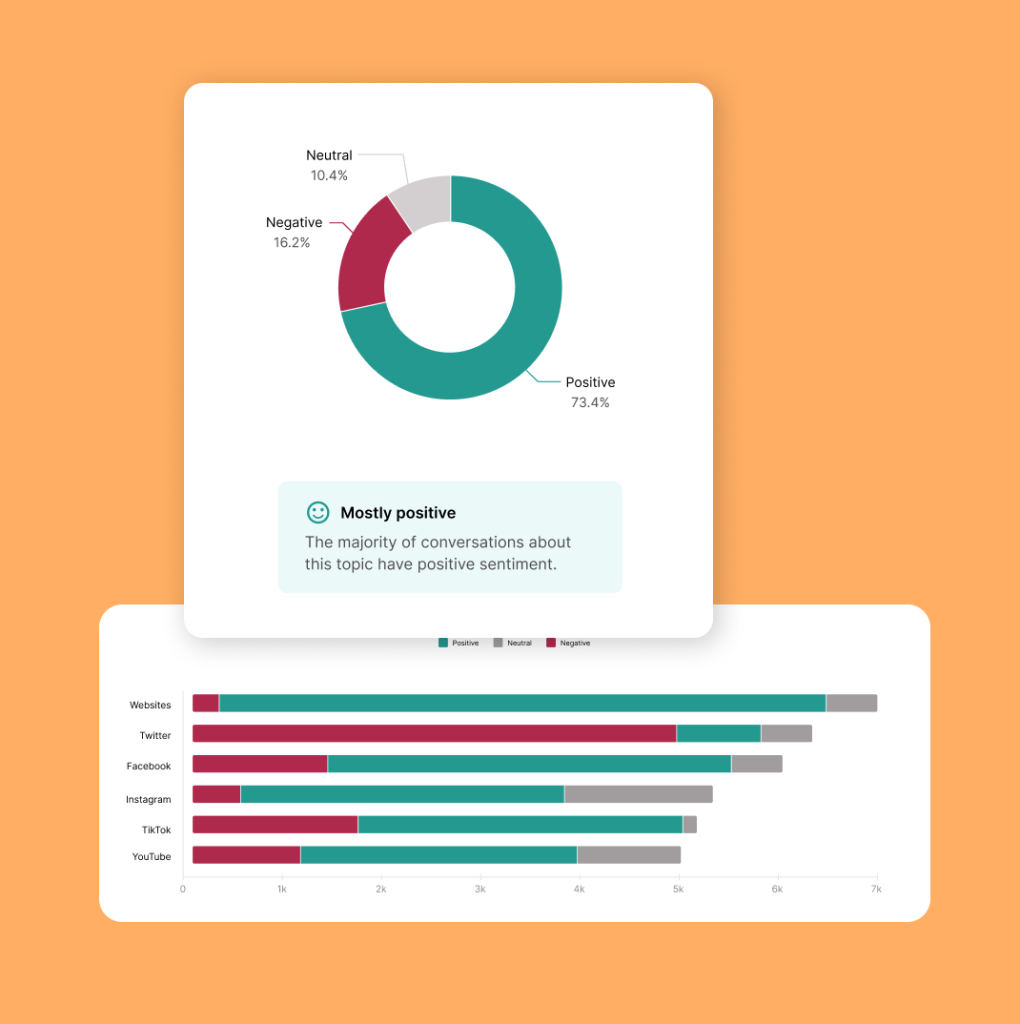
Monitor your brand reputation in real-time with Determ.
Features of Sentiment Analysis Tools
We talked about how to implement sentiment analysis. But you can’t do that without the right sentiment analysis software.
Here are key features to look out for.
Speed and scalability
Speed and scale are important benchmarks for evaluating sentiment analysis software.
You’re inputting a large amount of textual data into these tools. And while you want the results to be as accurate as possible, waiting too long for those results can be frustrating.
Multilingual Support
If you’re a global company with customers from all over the world, there’s a pretty strong chance that you’ll need a tool that analyzes text in different languages.
So, it’s important to look for a platform that allows you to conduct multilingual sentiment analysis.
Customization
Opinion mining isn’t a one-size-fits-all approach. The type of sentiment analysis you use will depend on your unique business goals and needs. So, customization is one of the biggest features to look out for.
Comprehensive Reports
A reporting dashboard is another crucial feature of sentiment analysis tools. There’s no point in gathering data about your customers’ experiences and thoughts if you can’t make those insights easy to analyze and actionable. So, a tool with a visualization dashboard is essential.
Determ’s AI media monitoring and analytics software allows you to save time with ready-made report templates. You can also create a customizable set of data unique to your own business goals.
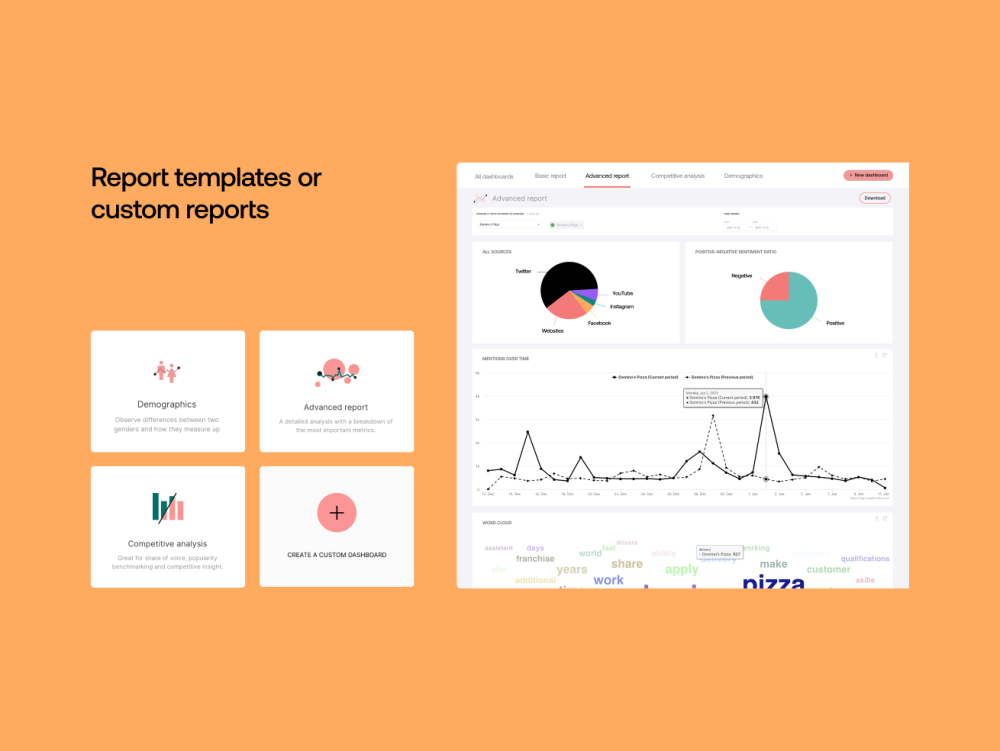
Create custom templates and reports with Determ
Make the Most of Your Customer Data With Sentiment Analysis
The bottom line: Sentiment analysis is a game-changer for brands trying to monitor their reputation and customer sentiment.
Thanks to natural language processing (NLP) software, you can get a general overview of what your customers are saying about your brand.
Whether it’s negative sentiment or positive sentiment, you can learn quite a bit about your customers and what you can do to improve their experience.
Looking to understand your target audience better so that you can take the necessary steps to boost customer satisfaction?
Determ can help you get started.
Author: Britney Steele was born and raised in Atlanta, Britney is a freelance writer with 5+ years of experience. She has written for a variety of industries, including marketing, technology, business, finance, healthcare, wellness, and fitness. If she’s not spending her time chasing after three little humans and two four-legged friends, you can almost always find her glued to a book or awesome TV series.